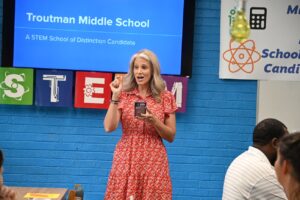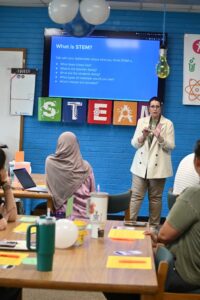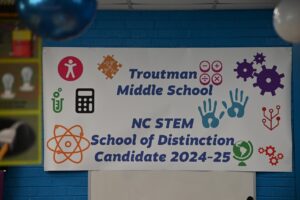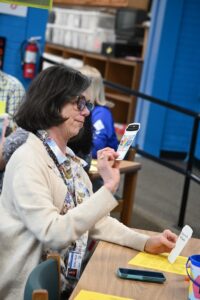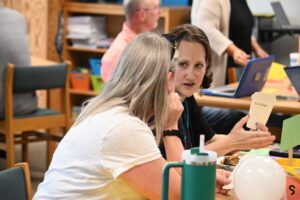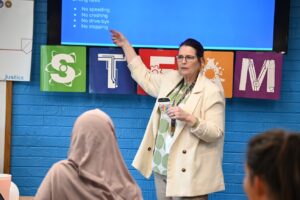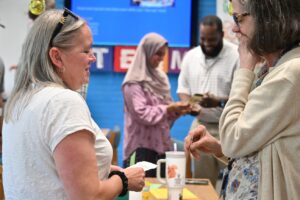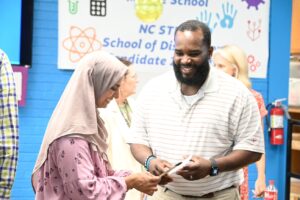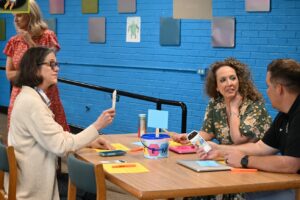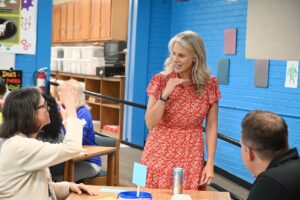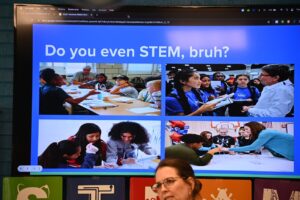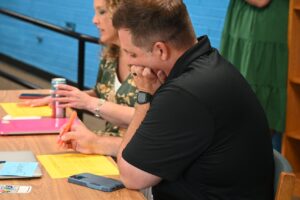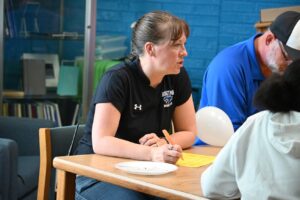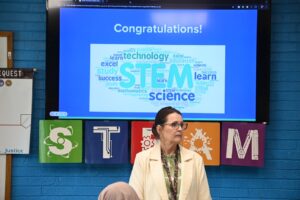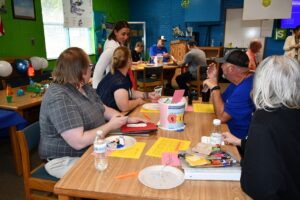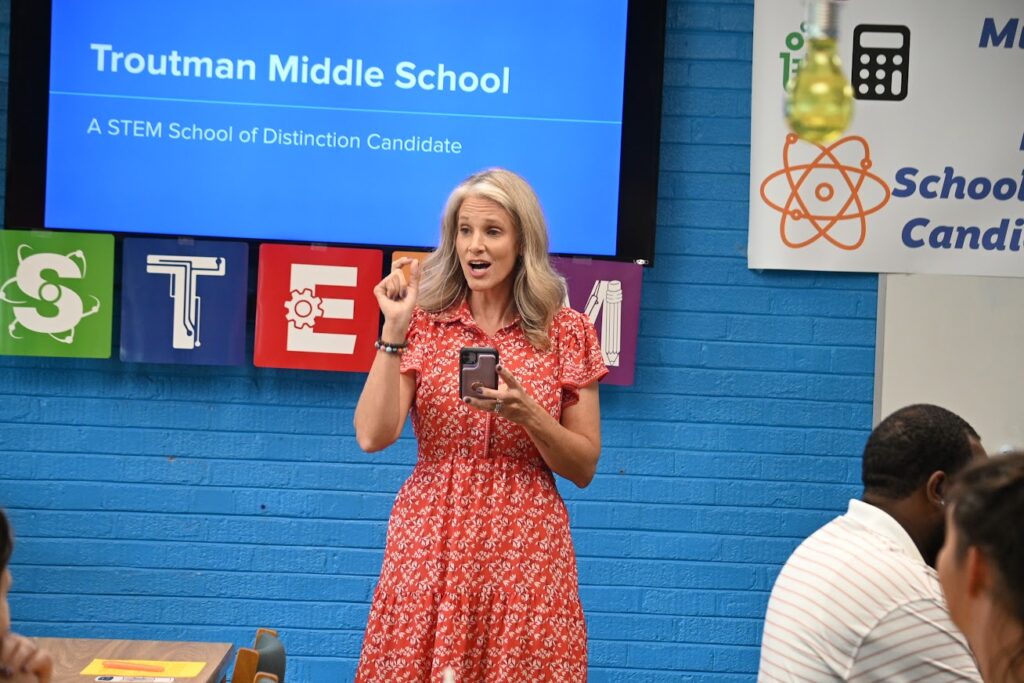
BY DEBBIE PAGE
Troutman Middle School teachers walked into a surprise party Tuesday to celebrate the journey to becoming an NC STEM School of Distinction.
Debra Lester, STEM coordinator for Iredell-Statesville Schools, assured the staff that they are already doing much of what is required to achieve the status. With some tweaks and adjustments, the faculty will be well on their way, she said.
Lester first asked teachers to talk for a few moments about what they thought STEM (Science, Technology, Engineering, Math) education involves, asking them what it looks like, how teachers’ and students’ roles change, what types of materials are used, and what classes are included in this view of learning.
After a small group discussion, Lester said that STEM is really about “highly engaging instructional practices, which emphasize critical thinking, problem-solving, creativity, innovation, and preparing students for future careers.”
To introduce the problem-based learning STEM schools aspire to, Lester asked teachers to engage in a “tea party” learning strategy. Each participant had to pick up a tea cup cut-out with a seemingly word random word on the back.
Teachers were then instructed to “socialize,” seeking to connect their word to another’s in a way that might make sense, while refraining from “speeding, crashing, drive-by, or stopping” during the interaction period.
Teachers milled about the room, gathering in small groups, sharing words, and trying to make some sense of how they were interconnected. After a period of interaction, Dr. Lester asked the teachers to return to their seats and discuss what they had experienced with their table mates and discover any new connections.
Next, Lester showed a short TED Ed video on Van Gogh’s psychotic break that led to his “Starry Night” masterpiece and its intriguing connection to brain science, making patterns of meaning, turbulent flow in fluid dynamics, and the amazing connections to the art of Van Gogh and other Impressionists.
All of the teachers’ words were part of this short video, blending art, science, technology, and math to explain the difficult physics concepts of movement, fluidity, and light. Suddenly, the random words were interconnected through the video and made sense.
Lester pointed out that as their word appeared in the video, they all displayed a flash of understanding through a nod or facial expression. Using such a simple concept as random words to spark students’ curiosity, problem-solving, and interest before introducing a concept gets them more deeply involved in their learning.
Worksheets and videos are still used in STEM but in intentional and purposeful ways that engage students, as the simple words on cards and a short video – all free – demonstrated in the mini lesson. Nothing has to be fancy or expensive to be effective and engaging in STEM education, Lester added.
Principal Rebecca Wilbur praised her staff’s hard work this year, saying she was so proud of the big gains their students achieved on recent i-Ready tests, already meeting their math goal for the year and reading scores leaping 12 percent in the green area.
With all this success, Wilbur is positive about the faculty’s ability and dedication to move forward with the STEM program. Next year will be a transition year to shift to STEM (and art) style problem-based learning. The following year the school will submit an application and provide evidence of the school’s STEM approaches to leading and learning.
Teachers can get ahead this summer and get their minds going with a project-based learning text that Wilbur has purchased for each faculty member to spark ideas about how to modify their lessons and content and look for cross-curricular lesson ideas to achieve a more STEM approach to teaching and learning.
Wilbur said that STEM will “allow our students and our teachers to be hands-on, engaged, all day long, and in order to improve the learning in our school, we need to have more engagement and have the kids really connected to all areas of the curriculum.”
Wilbur’s goal is for teachers to add elements of STEM-style learning regardless of their content area.
“We want the teachers to be able to partner, work together, to make lessons that cross curricular areas so that our enhancement teachers can see what they are learning in our academic areas and our academic areas can work together with them so students can see the connections between science and math, between social studies and English Language Arts and work as a team to do that.”
Lester said this type of education will be valuable for Troutman Middle School because “the data shows that STEM Schools of Distinction have had significant increases in their test scores and in levels of engagement and lowered instances of behavior problems.”
Lester also had the teachers look at one just page of the extensive 11-page STEM School of Distinction rubric so that they could see that they already do so much of the highest “model” level performance on many of the measured areas.
The rubric measures student opportunities to design learning, work in teams, connect to the real world, use digital technology, and participate in STEM organizations. Classroom environments are graded on the integration of content with STEM, using varied learning approaches, offering multiple assignment types, and collaborating with other teachers.
The school must have a professional learning focus with a specific delivery format and structure, physical space for projects, strategic staffing to enhance STEM learning, and offer a variety of STEM courses.
The STEM school must also reach out to STEM school networks to enhance student learning opportunities and share ideas and approaches, create an active STEM Business Advisory Council to support the program, and set up a communication strategy to share information widely in both the school and community about STEM education and activities.
Next year Troutman Middle School will be more focused on problem-based learning, creating cross curricular projects, teaching in more of a team approach, and working more collaboratively, perhaps in different professional learning community configurations.
“The collaborative piece is such a huge component of it, so we’ve got to get them talking to each other to share ideas and share the workload,” said Lester.
They will also get familiar with the rubric and implement those strategies more intentionally in a STEM approach and practice data collection to prepare for actual application to the STEM School of Distinction process and the collection of data and artifacts to earn the honor in the 2025-2026 school year.
After becoming a STEM School of Distinction, a school can reapply for another three-year term in its third year to avoid its status expiring.

